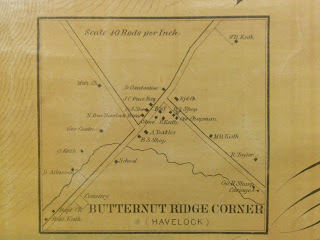It’s one of those objects that takes a lot of explanation for
the younger set.
Today’s hidden history artifact is a tobacco cutter,
manufactured by the Enterprise Manufacturing Company of Philadelphia, around
the mid-1880s. This rugged device with its cast iron body and sharpened blade was
a General Store staple, securely mounted to the store counter so that clerks
could cut off plugs of tobacco for customers at their request.
And boy, did Kings County shoppers request a LOT of tobacco.
A casual look through several of the store ledgers in our
collection shows tobacco being purchased with almost every order:
- Barrel of flour, plus a plug of tobacco
- 4 yards of cloth, plus a plug of tobacco
- Horse liniment, plus a plug of tobacco
 Smoking was so pervasive at the time that tobacco cutters
were in constant use and had to be well made to handle the workload. This weighty
model from the Enterprise Mfg. Co. in Pennsylvania (patented July 25, 1871) fit
the bill nicely. The brand was obviously a favorite of storekeepers throughout
Canada and the US, as a host of Enterprise’s devices can still be found
available for purchase in online antique auctions. They may show a bit of wear
or ‘patina’ from their use, but nothing to suggest the daily workout that they
undertook to supply our ancestors with a bit of tabaccy.
Smoking was so pervasive at the time that tobacco cutters
were in constant use and had to be well made to handle the workload. This weighty
model from the Enterprise Mfg. Co. in Pennsylvania (patented July 25, 1871) fit
the bill nicely. The brand was obviously a favorite of storekeepers throughout
Canada and the US, as a host of Enterprise’s devices can still be found
available for purchase in online antique auctions. They may show a bit of wear
or ‘patina’ from their use, but nothing to suggest the daily workout that they
undertook to supply our ancestors with a bit of tabaccy.
Though our ancestors were extremely familiar with the
tobacco cutter, our modern Kings County audience does not recognize the tool at
all. For most of our young visitors, tobacco is the mysterious item hidden in
steel shelving units at the local convenience store (requiring a photo ID and a
note from the parish priest before purchasing can occur). To explain the
tobacco cutter involves explaining the popularity of smoking in the past; the growing
and transport of tobacco from the South; and the preparation of tobacco by the
smoker (i.e. papers, matches, and a spot far from the granary).
Of course, our tobacco explanation always finishes with an
admonition that they not try any of this at home.
It’s our modern way of cutting smoking.
It’s our modern way of cutting smoking.
















